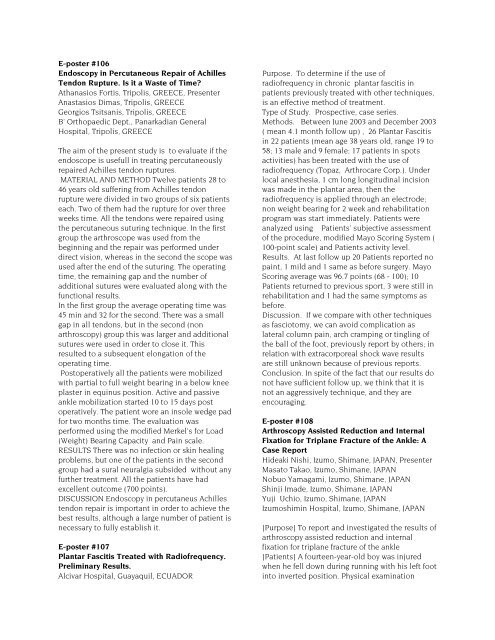POSTER ABSTRACTS - ISAKOS
POSTER ABSTRACTS - ISAKOS
POSTER ABSTRACTS - ISAKOS
Create successful ePaper yourself
Turn your PDF publications into a flip-book with our unique Google optimized e-Paper software.
E-poster #106<br />
Endoscopy in Percutaneous Repair of Achilles<br />
Tendon Rupture. Is it a Waste of Time?<br />
Athanasios Fortis, Tripolis, GREECE, Presenter<br />
Anastasios Dimas, Tripolis, GREECE<br />
Georgios Tsitsanis, Tripolis, GREECE<br />
B' Orthopaedic Dept., Panarkadian General<br />
Hospital, Tripolis, GREECE<br />
The aim of the present study is to evaluate if the<br />
endoscope is usefull in treating percutaneously<br />
repaired Achilles tendon ruptures.<br />
MATERIAL AND METHOD Twelve patients 28 to<br />
46 years old suffering from Achilles tendon<br />
rupture were divided in two groups of six patients<br />
each. Two of them had the rupture for over three<br />
weeks time. All the tendons were repaired using<br />
the percutaneous suturing technique. In the first<br />
group the arthroscope was used from the<br />
beginning and the repair was performed under<br />
direct vision, whereas in the second the scope was<br />
used after the end of the suturing. The operating<br />
time, the remaining gap and the number of<br />
additional sutures were evaluated along with the<br />
functional results.<br />
In the first group the average operating time was<br />
45 min and 32 for the second. There was a small<br />
gap in all tendons, but in the second (non<br />
arthroscopy) group this was larger and additional<br />
sutures were used in order to close it. This<br />
resulted to a subsequent elongation of the<br />
operating time.<br />
Postoperatively all the patients were mobilized<br />
with partial to full weight bearing in a below knee<br />
plaster in equinus position. Active and passive<br />
ankle mobilization started 10 to 15 days post<br />
operatively. The patient wore an insole wedge pad<br />
for two months time. The evaluation was<br />
performed using the modified Merkel’s for Load<br />
(Weight) Bearing Capacity and Pain scale.<br />
RESULTS There was no infection or skin healing<br />
problems, but one of the patients in the second<br />
group had a sural neuralgia subsided without any<br />
further treatment. All the patients have had<br />
excellent outcome (700 points).<br />
DISCUSSION Endoscopy in percutaneus Achilles<br />
tendon repair is important in order to achieve the<br />
best results, although a large number of patient is<br />
necessary to fully establish it.<br />
E-poster #107<br />
Plantar Fascitis Treated with Radiofrequency.<br />
Preliminary Results.<br />
Alcivar Hospital, Guayaquil, ECUADOR<br />
Purpose. To determine if the use of<br />
radiofrequency in chronic plantar fascitis in<br />
patients previously treated with other techniques,<br />
is an effective method of treatment.<br />
Type of Study. Prospective, case series.<br />
Methods. Between June 2003 and December 2003<br />
( mean 4.1 month follow up) , 26 Plantar Fascitis<br />
in 22 patients (mean age 38 years old, range 19 to<br />
58; 13 male and 9 female; 17 patients in spots<br />
activities) has been treated with the use of<br />
radiofrequency (Topaz, Arthrocare Corp.). Under<br />
local anesthesia, 1 cm long longitudinal incision<br />
was made in the plantar area, then the<br />
radiofrequency is applied through an electrode;<br />
non weight bearing for 2 week and rehabilitation<br />
program was start immediately. Patients were<br />
analyzed using Patients' subjective assessment<br />
of the procedure, modified Mayo Scoring System (<br />
100-point scale) and Patients activity level.<br />
Results. At last follow up 20 Patients reported no<br />
paint, 1 mild and 1 same as before surgery. Mayo<br />
Scoring average was 96.7 points (68 - 100); 10<br />
Patients returned to previous sport, 3 were still in<br />
rehabilitation and 1 had the same symptoms as<br />
before.<br />
Discussion. If we compare with other techniques<br />
as fasciotomy, we can avoid complication as<br />
lateral column pain, arch cramping or tingling of<br />
the ball of the foot, previously report by others; in<br />
relation with extracorporeal shock wave results<br />
are still unknown because of previous reports.<br />
Conclusion. In spite of the fact that our results do<br />
not have sufficient follow up, we think that it is<br />
not an aggressively technique, and they are<br />
encouraging.<br />
E-poster #108<br />
Arthroscopy Assisted Reduction and Internal<br />
Fixation for Triplane Fracture of the Ankle: A<br />
Case Report<br />
Hideaki Nishi, Izumo, Shimane, JAPAN, Presenter<br />
Masato Takao, Izumo, Shimane, JAPAN<br />
Nobuo Yamagami, Izumo, Shimane, JAPAN<br />
Shinji Imade, Izumo, Shimane, JAPAN<br />
Yuji Uchio, Izumo, Shimane, JAPAN<br />
Izumoshimin Hospital, Izumo, Shimane, JAPAN<br />
[Purpose] To report and investigated the results of<br />
arthroscopy assisted reduction and internal<br />
fixation for triplane fracture of the ankle<br />
[Patients] A fourteen-year-old boy was injured<br />
when he fell down during running with his left foot<br />
into inverted position. Physical examination
















